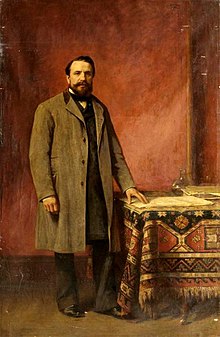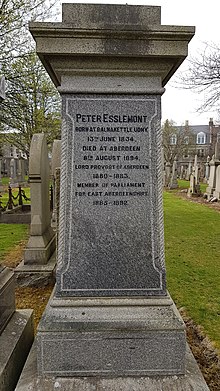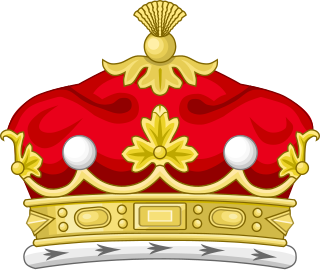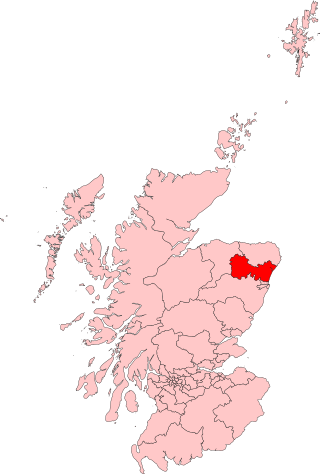
Peter Esslemont (13 June 1834 – 8 August 1894) [1] was a Scottish Liberal politician who sat in the House of Commons from 1885 to 1892.

Peter Esslemont (13 June 1834 – 8 August 1894) [1] was a Scottish Liberal politician who sat in the House of Commons from 1885 to 1892.
Esslemont was born in Balnakettle, Udny, Aberdeenshire the son of Peter Esslemont, a farmer, and his wife Ann Connon. He was educated at Public School, Belhelvie. He became head of Esslemont and Macintosh, warehousemen, of Aberdeen and a director of the Scottish Employers Liability Co. He was President of the Chamber of Commerce, a J.P. for Aberdeenshire and author of Scheme for Improvement of Robert Gordon's Hospital.From 1880 until 1883, he was the Lord Provost of Aberdeen [2] In 1884, he was a guest at Haddo House for a dinner hosted by John Hamilton-Gordon, 1st Marquess of Aberdeen and Temair in honour of William Ewart Gladstone on his tour of Scotland. [3]
Esslemont was first elected as the Liberal Member of Parliament for East Aberdeenshire at the 1885 general election. He remained an MP there until he resigned in late 1892 to take up the post of Chairman of the Fisheries Board for Scotland. [4]

He lived his final years at 34 Albyn Place in Aberdeen. [5]
He died in Aberdeen in 1894 aged 60 and is buried at the Nellfield Cemetery.
Esslemont married Georgia Anna Birnie at Walkmill, New Deer in 1857 and they had six children. Georgia died in 1871 and he married again in 1876 to Mary Anna Sherwood daughter of Rev. William Bradford Sherwood, of United States of America and went on to have a further five children. Peter Esslemont is related to John Esslemont.

Marquess of Aberdeen and Temair, in the County of Aberdeen, in the County of Meath and in the County of Argyll, is a title in the Peerage of the United Kingdom. It was created on 4 January 1916 for John Hamilton-Gordon, 7th Earl of Aberdeen.

Aberdeen South is a burgh constituency of the House of Commons of the Parliament of the United Kingdom which elects one Member of Parliament (MP) by the first-past-the-post system of election.

Aberdeen North is a burgh constituency of the House of Commons of the Parliament of the United Kingdom and it elects one Member of Parliament (MP) by the first past the post system of election. It was first used in the 1885 general election, but has undergone various boundary changes since that date. The seat has been held by Kirsty Blackman of the Scottish National Party since 2015.

West Aberdeenshire and Kincardine is a county constituency of the House of Commons of the Parliament of the United Kingdom of Great Britain and Northern Ireland (Westminster), which elects one Member of Parliament (MP) by the first past the post system of election. It was first used in the 1997 general election, but has undergone boundary changes since that date. West Aberdeenshire and Kincardine was re-created as a parliamentary constituency in 1997, having previously existed as Kincardine and Western Aberdeenshire from 1918 to 1950.

Gordon was a county constituency of the House of Commons of the Parliament of the United Kingdom (Westminster), which elected one member of Parliament (MP) by the first past the post system of election. The constituency was first contested at the 1983 UK general election; and underwent boundary throughout its existence.
Aberdeen and Kincardine Central, also known as Central Aberdeenshire, was a county constituency of the House of Commons of the Parliament of the United Kingdom from 1918 until 1950. It elected one Member of Parliament (MP) by the first past the post system of election.
EastAberdeenshire was a Scottish county constituency of the House of Commons of the Parliament of the United Kingdom from 1868 to 1918 and from 1950 to 1983. It elected one Member of Parliament (MP) by the first past the post system of election.
WestAberdeenshire was a Scottish county constituency of the House of Commons of the Parliament of the United Kingdom from 1868 to 1918 and from 1950 to 1983. It elected one Member of Parliament (MP) by the first past the post system of election.
Kincardineshire was a constituency of the House of Commons of the Parliament of Great Britain from 1708 to 1801 and of the Parliament of the United Kingdom from 1801 to 1918. It was represented by one Member of Parliament (MP).
William Gordon, 2nd Earl of Aberdeen, known between c. 1691 and 1720 as Lord Haddo, was a Scottish landowner and Tory politician who sat in the British House of Commons briefly from 1708 to 1709 when he was declared ineligible, being the eldest son of a Scottish peer. He showed some Jacobite sympathies, but took no part in the rebellions.
General Sir Alexander Hamilton-Gordon, was a Scottish soldier and Liberal Party politician.

Vice-Admiral William Gordon was a Scottish naval commander and Tory politician.
John Edward Gordon was a British Conservative Party politician.
Alexander Theodore Gordon was a Scottish Unionist Party politician. He was elected as the Member of Parliament (MP) for Aberdeen and Kincardine Central in the 1918 General Election, but died two months later.
James William Barclay was a Scottish businessman, farmer and politician. For nineteen years he was member of parliament for Forfarshire.

Robert Farquharson was a Scottish medical doctor and Liberal politician, who served as the Member of Parliament (MP) for Aberdeenshire West for 25 years.

John Campbell Hamilton-Gordon, 1st Marquess of Aberdeen and Temair, was a British politician. Born in Edinburgh, Aberdeen held office in several countries, serving twice as Lord Lieutenant of Ireland and serving from 1893 to 1898 as Governor General of Canada.
John Webster LLD was a Scottish lawyer and a Liberal politician who sat in the House of Commons from 1880 to 1885.
The 1917 Aberdeen South by-election was a parliamentary by-election for the House of Commons constituency of Aberdeen South comprising the local government wards in the southern part of the city of Aberdeen. The by-election took place on 3 April 1917.
William Leslie, was a Scottish Conservative Party politician.